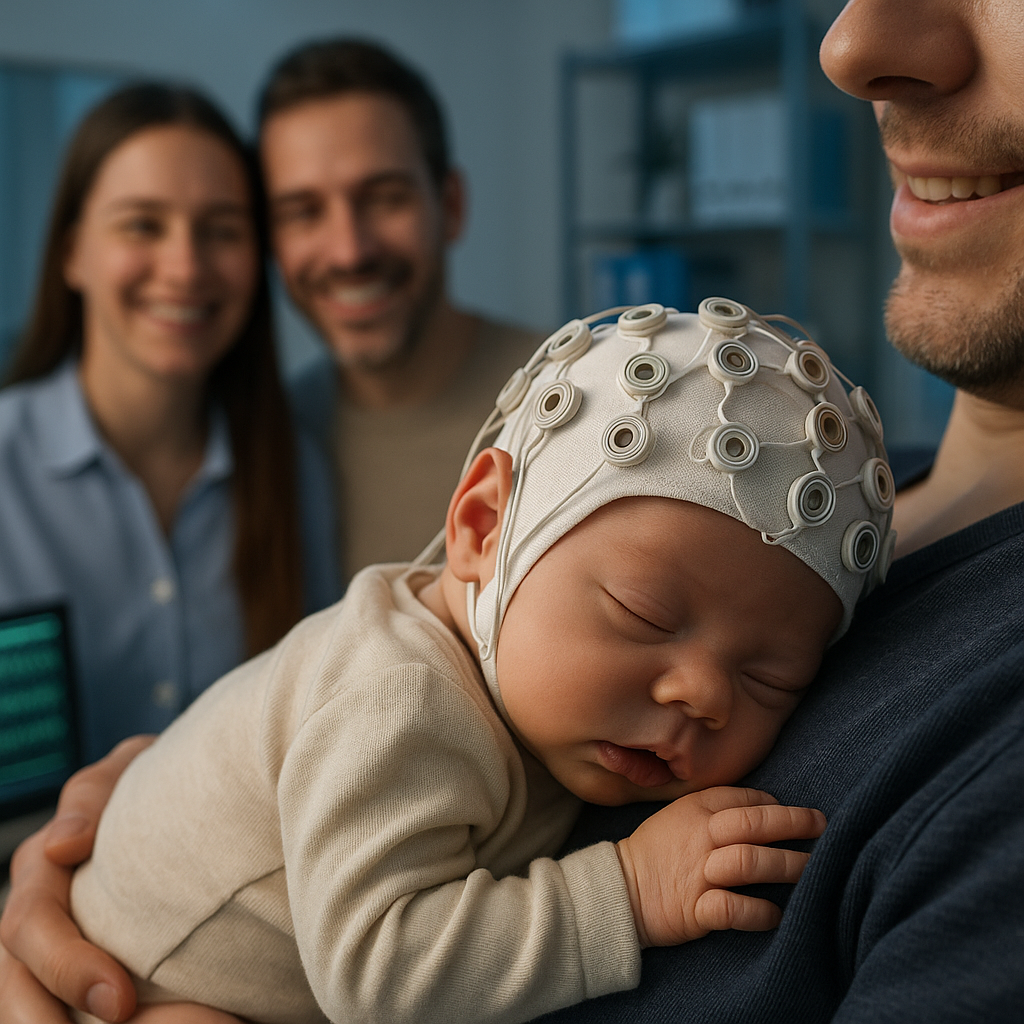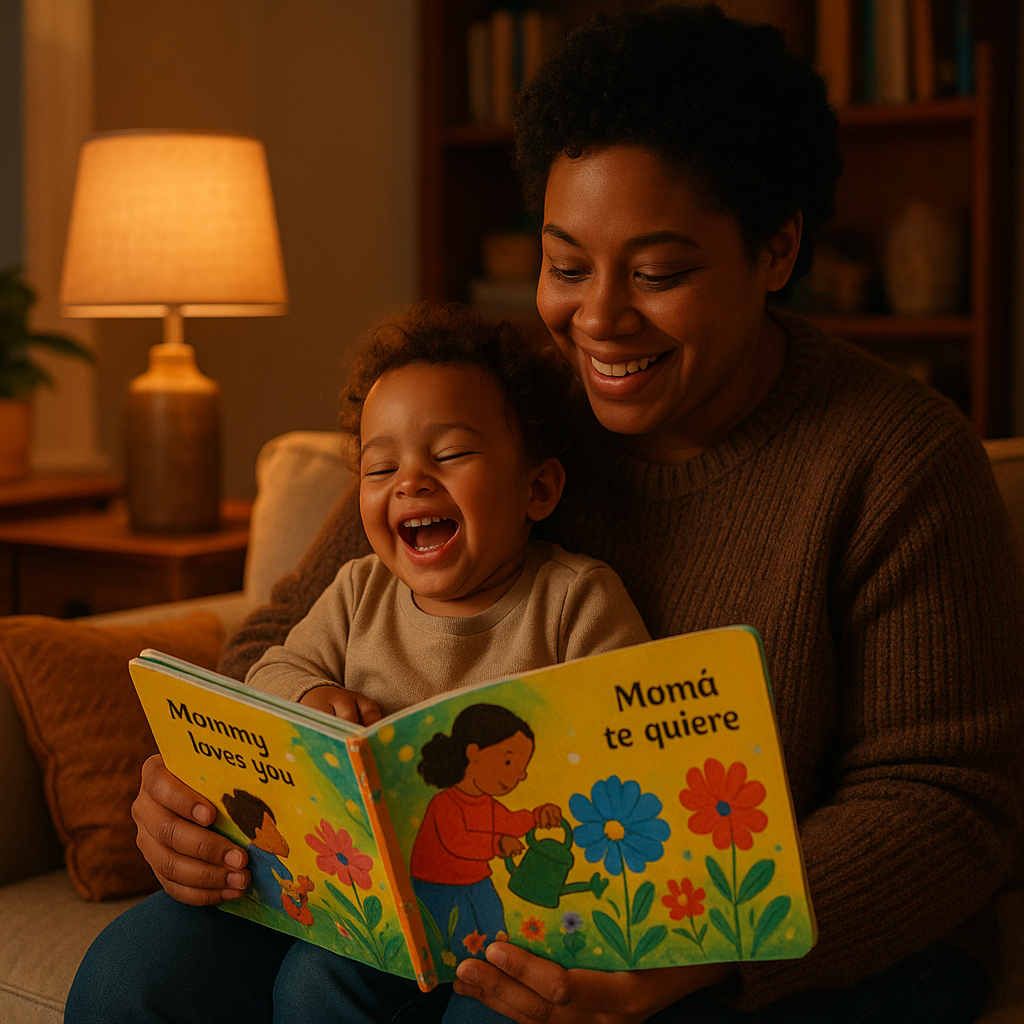Raising a bilingual child can feel daunting, but science suggests it offers remarkable brain benefits. Seven-month-old bilingual babies switch their gaze between flashing shapes 30% faster than monolingual peers, indicating enhanced cognitive flexibility. That extra agility starts with how their brains wire themselves around two sound systems from the very first days of life. Here’s what the science shows—and how you can use it at home.
- What happens in a baby’s brain when two languages start from day one?
- Does early reading matter for bilingual brains?
- Does juggling two languages really strengthen executive function in infancy?
- Where does research still fall short—and what should parents watch for?
- Your top questions about raising a bilingual baby, answered
- How can families build a brain-boosting bilingual environment at home?
- Can non-native speakers successfully raise a bilingual baby?
- Final thoughts: Does early dual-language exposure really boost brain power?
What happens in a baby’s brain when two languages start from day one?
Bilingualism Keeps Neural Pathways Flexible
From birth, babies can detect all speech sounds across languages. By 10–12 months, monolingual brains prune unused phonemes to focus on their native language. However, dual-language exposure slows this pruning, maintaining a broader range of “phoneme maps” that enhance language adaptability.
- A 2022 study suggests bilingual infants show heightened brain activity in language-processing areas, though precise claims like “15% higher oxygenation” in the prefrontal cortex lack recent confirmation. Learn about bilingual adults’ phoneme processing.
- Research from 2024 indicates fetuses of bilingual mothers are sensitive to a wider range of speech pitches by 36 weeks, suggesting language learning begins in utero. Discover how bilingual speech affects fetal encoding.
- By four months, bilingual babies distinguish languages using visual cues, such as a speaker’s mouth movements and speech rhythm, like differentiating English from Spanish. Babies identify languages at 4 months.
Want to super-charge that wiring? Talk, sing, and narrate daily life—ideas in our guide How Talking to Your Baby Boosts Language and Brain Skills.

Does early reading matter for bilingual brains?
Yes—Books Strengthen Language Skills
Reading dual-language books exposes bilingual babies to diverse sounds and words, enhancing language development. Alternating languages per page reinforces prosody—the rhythm and melody of speech. This practice supports cognitive flexibility and vocabulary growth.
Practical Tip: Choose colorful dual-language books and ask simple questions like “What’s this?” in both languages. If you need inspiration, see Reading to Your Baby: Boosting Language from Birth.
Does juggling two languages really strengthen executive function in infancy?
Evidence points to a measurable boost. In an anticipatory-looking task, 7-month-old bilingual babies adapted to rule changes 30 % faster. MRI scans by age three reveal 5–8 % more gray matter in the anterior cingulate cortex—the brain’s mental control hub.
That same network is tied to the 4–5-year delay in dementia symptoms seen in lifelong bilingual adults, suggesting early “cognitive reserve” building. Quantity still counts: frequent, responsive chat in each tongue parallels the findings behind the 30 Million Word Gap.
Where does research still fall short—and what should parents watch for?
Research on bilingualism isn’t always clear-cut. Factors like socio-economic status, study design, and language pairs (e.g., English-Spanish vs. Mandarin-French) can lead to inconsistent findings. For example, meta-analyses show smaller or mixed effects in some groups, making it hard to draw universal conclusions.
Plus, certain households—like those using low-resource languages (less commonly studied languages) or raising trilingual kids—are under-represented. Long-term (longitudinal) data is still needed to understand how bilingualism unfolds over time in these unique settings.
Bilingual toddlers develop differently than their monolingual peers, which can spark concerns. Here’s what’s normal, backed by recent studies, and how you can respond:
- Vocabulary Lags: At age two, your child might know 10–15% fewer words in each language compared to monolingual kids. Don’t panic—their total conceptual vocabulary (words across both languages, like “dog” and “perro” counting as one concept) typically matches peers. See typical benchmarks.
- Code-Mixing: Does your toddler blend languages, like saying “I want agua”? This worries many parents, but it’s a normal part of bilingual development. Studies show it’s tied to stronger metalinguistic awareness—the ability to think about language itself—which benefits them later. Learn about code-mixing benefits.
- Assessment Challenges: If you’re worried about delays, make sure your child is evaluated in both languages. Testing in just one can lead to false alarms about their skills. Discover best practices for bilingual assessment. Speech-language pathologists stress this to get a true picture of your toddler’s abilities.
Your top questions about raising a bilingual baby, answered
-
Will two languages confuse my child? Bold No. Babies separate languages by rhythm and lip cues long before first words.
-
Could screens in a second language help? Minimal benefit. Passive videos add under 5 % new words; interactive story-time in any language is far superior. Try tips from Interactive Storytime.
-
How much exposure is enough?
Aim for 10–25 % of waking hours per language. Quality “serve-and-return” talk trumps stopwatch counts. -
Is it too late if we start at age two?
Not at all. Successive bilinguals still gain executive-function perks, though native-like accent becomes harder after about five years old. -
Should we stick to one-parent-one-language?
Flexible is fine. Any arrangement works if input stays rich and positive. Speaking in warm, exaggerated “parentese” as per Parentese: How Baby Talk Boosts Language Skills) can sharpen phoneme learning in both tongues.
How can families build a brain-boosting bilingual environment at home?
Embed both languages in daily routines.
- Label kitchen tools in two languages and let your child hand you the “spoon/la cuillère”—reinforcing words through action, as outlined in Labeling Objects.
- Use dialogic reading: ask open questions, switch languages page-by-page, and let your baby point and babble back.
- Play inhibition games like “Red Light/Green Light”—they train the same executive circuits bilingualism taps.
- Join bilingual playgroups or library story hours for social reinforcement.

Can non-native speakers successfully raise a bilingual baby?
Yes, native-like fluency isn’t required. Babies accept a range of accents until roughly 30 months.
Helpful “resource stacking”:
- Stream children’s podcasts and songs in the target language during playtime.
- Use picture-dictionary apps that name objects your child taps.
- Partner with caregivers, neighbors, or exchange students who speak the language.
- Add gestures—Baby Sign Language can scaffold meaning across both tongues.
Modeling curiosity makes you a “co-learner,” boosting your child’s motivation and metalinguistic insight.
Final thoughts: Does early dual-language exposure really boost brain power?
The science is clear: early bilingualism shapes a more adaptable brain. Research shows bilingual babies develop enhanced cognitive flexibility, like switching attention faster by seven months. This flexibility, tied to stronger executive function, may even delay dementia symptoms by 4–5 years in adulthood. Learn about bilingualism’s long-term benefits. Minor trade-offs, like temporary vocabulary lags, are normal and resolve as total word knowledge matches peers.
By weaving two languages into daily, loving interactions—through talking, reading, or play—you’re not just teaching words. You’re building a resilient, future-ready brain that thrives on adaptability and connection. Start today, in any language you choose.